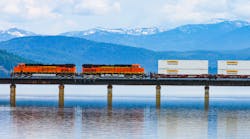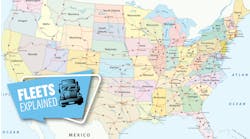While noting that the U.S. freight market began to “find more balance” in recent weeks, a top J.B. Hunt Transport Services Inc. executive said April 18 there’s no clear sign yet that the broader economy is heading for a slowdown.
“Demand for our services and, in particular, the asset side of our business is the strongest I have seen in my 27-year career at the company,” Chief Commercial Officer Shelley Simpson told analysts and investors on a conference call discussing J.B. Hunt’s first-quarter earnings. “This demand continues to put pressure on our need for more equipment and people.”
See also: Pent-up demand keeps softening freight market moving
Simpson added that it’s too early for the J.B. Hunt team, which ranks fifth on FleetOwner’s 2022 Top 500: For-Hire Fleets with more than 19,000 tractors, to say if U.S. consumers’ spending attitudes are shifting. A big driver of the company’s business, she said, is the continued friction in the market due to the combination of COVID-19, a shortage of labor, and other supply chain factors.
Those dynamics helped Arkansas-based J.B. Hunt produce a first-quarter net profit of $243 million on total revenues of nearly $3.5 billion, increases from $147 million and $2.6 billion a year earlier. Operating income jumped to $334 million from $208 million, with intermodal accounting for $93 million of that increase. Per diluted share, net income was $2.29, which beat analysts’ consensus estimate by nearly 20%.
Intermodal work accounted for 46% of J.B. Hunt’s first-quarter revenues and is set to grow that share. Under the umbrella of a long-term extension of its work with BNSF Railway Co., the company plans to grow its intermodal fleet by 40% to 150,000 containers in the next three to five years. A significant part of that growth will backfill capacity that Schneider National Inc. and Knight-Swift Transportation Holdings Inc. are taking to BNSF rival Union Pacific. Still, the division's president, Darren Field, said his team plans to bring on new customers looking to intermodal as an alternative to highways.
Other notes from J.B. Hunt’s call included:
- Chinese authorities’ COVID-19 lockdown strategy has provided some temporary relief to crowded shipping lanes and port operations, but Simpson said the J.B. Hunt team is forecasting things will “get a lot worse as we come into the summer months” and now-stationary cargo begins to move again. “In this type of an environment, it just takes a little bit of disruption to really change the environment all over again,” Simpson added.
- J.B. Hunt has grown its driver force by more than 1,400 so far in 2022, adding to the nearly 1,900 net drivers the company added last year.
- Nick Hobbs, COO and president of J.B. Hunt’s contract services group, said the company is exploring new equipment suppliers to help it meet the demand for its services. Key manufacturers have pitched in so far, he said, “but I am afraid it’s not enough.”
Shares of J.B. Hunt (Ticker: JBHT) were essentially flat around $171 in morning trading April 19. They are down about 10% over the past six months after investors pushed up the trucking sector in late 2021 before quickly retreating again earlier this year.




